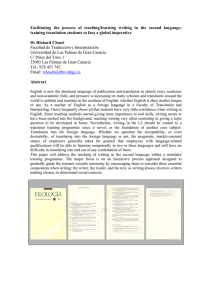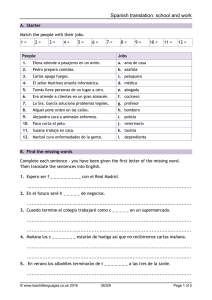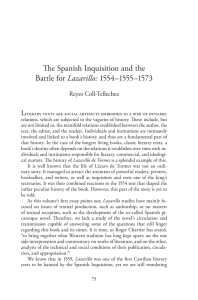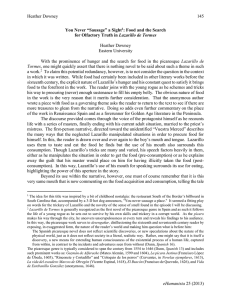PROBLEMS IN THE TRANSLATION OF LAZARILLO
Anuncio
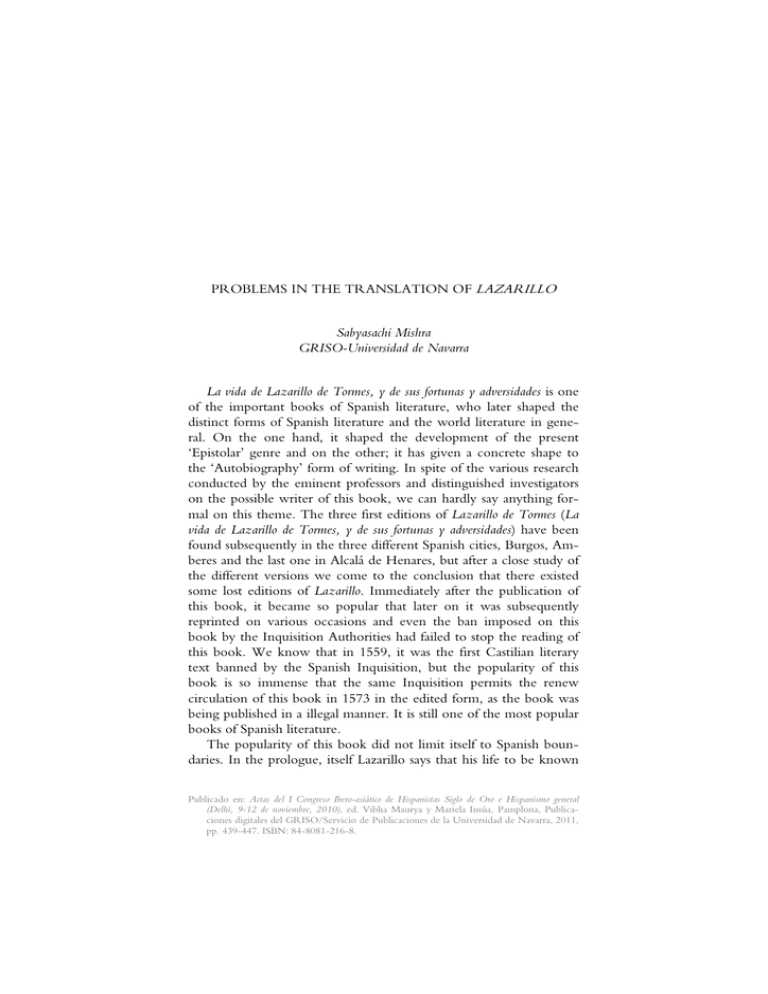
PROBLEMS IN THE TRANSLATION OF LAZARILLO Sabyasachi Mishra GRISO-Universidad de Navarra La vida de Lazarillo de Tormes, y de sus fortunas y adversidades is one of the important books of Spanish literature, who later shaped the distinct forms of Spanish literature and the world literature in general. On the one hand, it shaped the development of the present ‘Epistolar’ genre and on the other; it has given a concrete shape to the ‘Autobiography’ form of writing. In spite of the various research conducted by the eminent professors and distinguished investigators on the possible writer of this book, we can hardly say anything formal on this theme. The three first editions of Lazarillo de Tormes (La vida de Lazarillo de Tormes, y de sus fortunas y adversidades) have been found subsequently in the three different Spanish cities, Burgos, Amberes and the last one in Alcalá de Henares, but after a close study of the different versions we come to the conclusion that there existed some lost editions of Lazarillo. Immediately after the publication of this book, it became so popular that later on it was subsequently reprinted on various occasions and even the ban imposed on this book by the Inquisition Authorities had failed to stop the reading of this book. We know that in 1559, it was the first Castilian literary text banned by the Spanish Inquisition, but the popularity of this book is so immense that the same Inquisition permits the renew circulation of this book in 1573 in the edited form, as the book was being published in a illegal manner. It is still one of the most popular books of Spanish literature. The popularity of this book did not limit itself to Spanish boundaries. In the prologue, itself Lazarillo says that his life to be known Publicado en: Actas del I Congreso Ibero-asiático de Hispanistas Siglo de Oro e Hispanismo general (Delhi, 9-12 de noviembre, 2010), ed. Vibha Maurya y Mariela Insúa, Pamplona, Publicaciones digitales del GRISO/Servicio de Publicaciones de la Universidad de Navarra, 2011, pp. 439-447. ISBN: 84-8081-216-8. 440 PROBLEMS IN THE TRANSLATION OF LAZARILLO by many and should be remembered for its relevance and curiosity, so within a very small period of time, it was translated into many different European languages. It was translated in French in 1560, in English 1576, in Dutch in 1579, in German in 1614; however the translation was published in 1617, and in Italian 1622. So we can say that within a less span of time, the life of Lázaro was not limited to only Spanish speaking people only. I don’t know about the translations of Lazarillo in Indian languages. This year, Lazarillo has been translated into Hindi under the financial assistance from Spanish Government and guidance from the professors from the Universidad de Navarra, as this text is easy and complex at the same time and there are so many subtexts and cultural connotations in the text, which are difficult to understand without the help of professors. I would like express my sincere acknowledgements to Prof. Ignacio Arellano and Prof. Carlos Mata, who explained the various subtle and contextual meanings of the different chapters of Lazarillo de Tormes. It is very hard to escape from the charm of Lazarillo, who narrates his story in the form of letter. It is partially autobiographical and partially epistolary in nature. In his narration; Lazarillo describes us his life from his early childhood till his marriage with the maid of Archbishop of San Salvador Church in Toledo. During this process of transformation of an honest and innocent child to an experienced person, he works under different masters and thus we see the different persons of the society in their original colour. He also describes the “case” in detail, which he hints in the beginning of the book. For me, as a translator of the book, it was quite difficult to maintain the original flavor of the book in its original form in another language in which the cultural and social perceptions are quite different. I would like to begin with the cultural elements of the book. Before saying this, I would like to underline the fact that both language and culture are closely related with each other and any translation is not justified when we do not keep in the mind the cultural elements of the particular society or time period while translating the book. Foremost, It has been translated for the people, who have a deep interest in reading, which is different and has shaped the world literature in general. Then I know that among the general Indian readers, most for the persons have a specific interest in Spanish literature, as it is a new field and people like to know something which is different and at the same time new. One of the various functions of the trans- SABYASACHI MISHRA 441 lations is to convey the inherent socio-economic and political factors of the book and the contemporary era, and in my translation of the book, I have tried to convey the distinct elements of the Spanish culture and society through foot notes, which are clearly explained. I would like to talk about some concepts which are very less known by the Indian readers, so that they can enjoy the reading of the book. Right from the first statement, in which Lazarillo declares that «Pues sepa Vuestra merced, ante todas las cosas, que a mí llaman Lázaro de Tormes […] Mi nacimiento fue dentro del río Tormes, por la cual causa tomé el sobrenombre», he is talking about the concept of the honor present in the medieval Spanish society. The surname ‘De…’ was excessively used by the contemporary nobility. To show his ‘honor’, he uses a language, which is full of literary and biblical examples, but in reality, at the same, he has left us much to decipher from the many examples, which he gives. I would like to present here a case from Tratado III, in which the Lazarillo says, «Desque fuimos entrados, quita de sobre sí su capa, y, preguntando si tenía mano limpias, la sacudimos y doblamos, y, muy limpiamente soplando un poyo que allí estaba, la puso en él.» If we simply read the text, then we will understand that his master is asking whether his hands are clean are not this text has some inherent meaning with the contemporary culture. The noble is asking him whether he belongs to a traditional Christian family, but Lazarillo, who does not know the meaning of the question, honestly shows him his hands. He gives us example in the text where describing his past, he keeps quiet or tells lie, but all his arguments are structured upon the literary texts which are presented or shown to us by the eminent experts of the Golden Age Literature. Here, I would like to say in many cases, when he say some phrases, or some statements, normally they are from Biblical origins or these statements are used from books of greater literary influence. I am just giving an example from the Tratado III, «¡Bendito seáis Vós, Señor —quedé yo diciendo—, que dais la enfermedad y ponéis el remedio.[…].» If we analyze this statement, then we will see that this statement has origins from The Holy Bible and from La Celestina. As a translator, initially I thought that Lázaro is always hungry, but during the process of translation, all of sudden I realized that like all the picaresque characters, Lazarillo is always worried about the food and he suffers hunger on many occasions in the novel, but the question which emerges from the reading of this text is 442 PROBLEMS IN THE TRANSLATION OF LAZARILLO that whether he is really a hungry person, or after seeing the food, he becomes hungry? The second thing, which I want to highlight from this discussion, is that in Lazarillo de Tormes, the real problem is not hunger, but how one can access the food, and through which manner is the question, and all his intents to get the food are the central theme of the actions from the Tratado I to Tratado III. After III tratado he librates from the problems of hunger and he thinks about the other things which any other person wants in life, and so we see references of a shoe and dress. The complete name of the book is La vida de Lazarillo de Tormes y sus fortunas y adversidades. The book begins with a contradiction. In Spanish ‘Vida¡ means life, the complete life, but in reality, here the real protagonist of this book is Lázaro, who is talking about his ‘case’ and to put his arguments that how much he has suffered in his life, he tells story right from the beginning of his life. But this book ends abruptly. He has been married, but he is not dead or his life is not yet finished. So, it is incomplete. The second important thing, which I want to highlight here, is that in his life he does not mentions about the other masters, or another vital experiences. He just gives description of some of his masters and leaves many thing to decipher, but they cannot be deciphered if we don´t know the social and cultural connotations of the era. The era in which in which Lazarillo is describing his experiences is Early Modern Spain. In this age, there was massive immigration from rural area to urban area. Various reasons were behind this phenomenon. Some of the important reasons which lead to outflux towards the cities were: bad harvest, hunger, better opportunities and rise of prices. So like a common person, Lazarillo also migrates from the rural area to urban area. When he leaves his home, he does not understand all these themes, but in the later phase of life, he is telling us about all this in the indirect manner. As a translator, I understood that there are certain themes on which Lázaro is not speaking. Here I would like to further highlight these themes. One of the major themes on which, Lázaro just give simple references of the women characters of this novel. There are some women characters in this novel, but during the narration of the tale, Lázaro hides many things. This novel is urban in nature and in any society women has its role. It was the time, when massive immigration to city was taking place, as there were lesser jobs in the tradi- SABYASACHI MISHRA 443 tional urban society. Women in all the forms are present in the life of Lazarillo. They appear as mother, widow, healers, prostitutes, street hawkers, servant and wife at the crucial moments in the life of Lazarillo. His mother Antona Pérez is an important female protagonist. She has suffered hunger and other hardships in the life. To manage her family, she takes a hard decisive step and marries with a black or Moorish person after the death of the first husband, but when this Zaide is arrested for robbing the military provisions for personal benefits, his mother is left alone. Now apart from Lazarillo, she has another child and in the Mesón of Solana she has suffered a lot. Lazarillo remembers all this but he does not speaks apart from the sentence «Y allí, padesciendo mil importunidades, se acabó de criar mi hermano hasta que supo andar, y a mí, hasta ser buen mozuelo […]». She is a common woman, who has suffered a lot in her life and in search of a better life, she becomes a marginalized woman. Lazarillo does not speak much about his mother. After his mother, he just gives the outline about another female person, who is an ensalmadora, the healer. When the avaricious priest beats him so much, the healer tries to heal her wounds. They were the marginalized woman who used to heal the ill, with prayers and medicine. Normally such practices have relationship with magic, and people consulted these women, however sometimes they were criticized for their relationship with supernatural powers. During the process of the translation of the novel, for me it was very surprising why the main protagonist is not speaking more on these women, who were the important part of the society. Again, when Lazarillo gives us references about the women who were with his Escudero, we immediately understand that these women belongs to the marginalized category of the society and to get the money, they are ready to use their body also. In any urban society, which is composed of distinct economic layers, there are the persons of all the economic levels. Similarly in the same chapter, we see the working class women of Early Modern Age. They are neighbors of Lazarillo, and are hilanderas de algodón. They help him from time to time particularly in feeding him and finally when he is detained due to misdeeds of his escudero, the women help him for his liberation. Again, the protagonist is silent on their behavior. The female protagonist, on whom Lazarillo speaks about a lot, is his wife. It is not that, he does not know anything, but he tries to see the material benefits what he obtains from his master and thus 444 PROBLEMS IN THE TRANSLATION OF LAZARILLO he does not say anything. He accepts the role, which has been decided by Archbishop. So, to show all this in the translation, was not an easy task. The silence of the protagonist increases the work of a translator, and in indeed it was a tough task from my side to represent all these marginalized voices in the translation, as they are shown in the novel. I think that it is an appropriate moment to analyze the character of «Vuesa Merced» as Lazarillo also does not talk of him. He is presented in the passive tone, one who wants to know, why people are talking about the family of the main protagonist. We don’t know much about the Vuesa Merced, but personally I think that this person is not from Toledo as he might have known as Lazarillo, but the infamy of our protagonist and clergy has gone to such heights, that he is inquiring about the matter, and this book ends abruptly, and at this particular moment I think that as he has become a mature person, so he starts writing the prologue of this book. Now I would like to concentrate on the second part of the paper, where I am dealing with the problems of text in the translation of the above said work. When we translate any work, we try to present the work in its original form as one of the many roles of the translator is of the reader also. In this case, a translator applies his knowledge on the author’s universe of discourse and various texts written on the main discourse also helps him. Here I would like to add that the language of the translation is good only when the translator has managed to render the original content in aesthetic and conceptual manner. Translation of any old text is more difficult as apart from the rendering the flavor of the old language, which is used by the author, we have to present the social details in the society. We all admit that the realism of the protagonist is evident from the very beginning from the novel. He tries to present the society and if we situate ourselves in the ambience of the contemporary society, the novel becomes more real. So any translator has to establish the mindset of a reader of these works in the era. I have talked a bit earlier on the case of women in Lazarillo de Tormes, as many things are just touched by the writer. For an average normal Indian reader, who does not know much about the Spanish society, cannot understand many things of the texts of the Spanish Golden Age, as we don’t know much about the things that happened in Spain. It is culturally very far from us. So in the translations of these texts, we have to be extremely cautious. A SABYASACHI MISHRA 445 translator should provide full details on the monetary system, the social order and aristocratic order etc to describe how the society was functioning in that period. It is important so that the reader can enjoy and understand the text. As the work is anonymous, so the critics have interpreted the text in different directions. The ambiguity of the text gives the different interpretations of the text for the reader and for the translators, who always tries to provide the best for the readers in the target language is a problem. Here I would like to highlight the example: Pues siendo yo niño de ocho años, achacaron a mi padre ciertas sangrías mal hechas en los costales de los que allí a moler venían, por lo cual fue preso, y confesó y no negó y padesció persecución por la justicia. Espero en Dios que está en la gloria, pues el Evangelio los llama bienaventurados. En este tiempo se hizo cierta armada contra moros entre los cuales fue mi padre, que a la sazón estaba desterrado por el desastre ya dicho, con cargo de acemilero de un caballero que allá fue; y con su señor, como leal criado, fenesció su vida. If we analyze this text we can see that it is ambiguous in nature. In very rounded words, he is saying that his father was robbing cereals, and then he was arrested for this crime. He uses the biblical terms to show the “greatness” of his father and again, he says that his father is one among Moors against whom the religious war was launched and finally his father became a martyr in his faith. I have shown this in the Hindi translation by using the footnote that indirectly Lazarillo is showing that he belongs to a family who is Moorish. Mostly in contemporary Europe, Millers were from Muslim origin and literal interpretation of the text has helped me. The second master of our protagonist, El Clérigo, maintains certain distance from him at the moment of food. Lazarillo normally does not describes in detail about the food habits of his masters, who plays an important role in the novel, but when it comes to the second master, immediately he starts describing, how he eats and what he eats: Cinco blancas de carne era su ordinario para comer y cenar. Verdad es que partí comigo del caldo, que de la carne ¡tan blando el ojo!, sino un poco de pan, y pluguiera a Dios que me demediara. 446 PROBLEMS IN THE TRANSLATION OF LAZARILLO Los sábados cómense en esta tierra cabezas de carnero, y enviábame por una, que costaba tres maravedís. Aquélla le cocía, y comía los ojos y la lengua y el cogote y sesos y la carne que en las quijadas tenía, y dábame todos los huesos roídos. In the Golden Age society, normally the food was also an important tool to distinguish the persons. In this section, we observe that the priest is limiting his access to certain types of food, which is bread and meat, in this manner he is restricting him to climb on the social structure of the society. With his first master, when the episode of tasting the meat arrives, he suffers the same situation. Since the blind man lacks home, and this priest lives in a shabby house, so the only thing by which they can differentiate with him is the food. All these restrictions don’t apply to him, when he comes in the contact of upper level clergy but he is paying for this price, and thus the whole novel is structured about the ‘case’. A translator should be well verse in these social conditions and in this case only he can justify with the text. A significant example of the text, which I have related to cultural context of the future readers, is in terms of the cultural myths of the characters. At this moment, I would like to cite this text from Lazarillo, «Y, como digo, él estaba entre ellas, hecho un Macías, diciéndoles más dulzuras que Ovidio escribió». In Indian context normally, love is related with Krishna, and typically with his Kanhaiya form. Before reading this book, I also did not what is the context of Macias, and thus for a normal reader it will be very difficult to understand the whole concept. Here it would to relate another concept of papal bulls. Many of us, from the Indian society don’t know about the papal bulls and the frauds which were used to do sell the papal bulls. So, while translating the chapter, I had to put the details about the history of papal bulls so that the reader, who is reading the text, can understand the chapter in a better in way. Now a reader of the translation of Lazarillo, where this protagonist has learnt to read and write, as in his autobiography he gives us references about the biblical and literary texts a number of times, can ask me that in his autobiography, he never told us that where he had studied? I would like to analyze this theme in detail. The book begins with a prologue in which the narrator has given references to Pliny, and gives an intellectual discourse on the books and the SABYASACHI MISHRA 447 readers. He quotes biblical terms and references and links with his personal life. In the due course of time, he becomes so intelligent that he directs his readers about his life, and evades telling some crucial moments of his life. Here I would like to take a pause as during the narration of his life, he takes there approach: sometimes he is telling us his autobiography in a direct simple style, sometimes his language is rich and full of literary references and sometimes he starts giving opinion on the life and various events related with honor. So, all these styles make his narration rich in style, and we are puzzled, when he has studied, and why he is not mentioning that he has studied at this particular moment? We are clueless about this question. I personally feel that Lazarillo de Tormes is based on the real experiences of a person, but as it has been related with the apocryphal writer, Lázaro, and is thus a source of various interpretations of the text. I personally think that great novel’s greatness lies that it is a story of a marginalized person who has been deceived and mocked several times. Initially, he tries to improve his situation, having his faith in the ideals of the society, but he accepts his position in the society and thus it has universal acceptability. Bibliography Anónimo, La vida de Lazarillo de Tormes, y de sus fortunas y adversidades, ed. F. Rico, Madrid, Cátedra, 1987. Lázaro Carreter, Fernando, Lazarillo de Tormes en la picaresca, Barcelona, Ariel, 1972. Mcdeal, S. y R. Coll-Tellechea (eds.), The Lazarillo Phenomenon, Lewisburg, Bucknell University Press, 2010. Navarro Durán, R., La verdad sobre el caso del Lazarillo de Tormes, Berriozar, Cénlit, 2010. St Pierre, P. y P. Kar (eds.), In Translation-Reflections, Refractions, Transformations, Philadelphia, John Benjamins, 2007.
![LAZARILLO DE TORMES [1554] I. The picaresque novel: A very](http://s2.studylib.es/store/data/006112216_1-4e896eb1740cff4d986357429306ead6-300x300.png)
